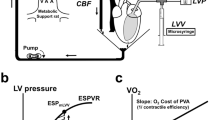Abstract
The energy status of mammalian cells is a finely regulated phenomenon. This is especially true in cardiac muscle cells in which energy requirements are high and the system must provide rapid turnover of the adenine nucleotides and instant response to changes in energetic demands. We have examined the acute response of the rat myocardium to ventricular pacing up to 2.5 times the resting heart rate. The purpose of this study was to determine at what level of pacing the normal energy status could be maintained and at what point it was compromised. Myocardial energy charge (EC = (ATP + 0.5 ADP)/(ATP + ADP + AMP)) was maintained at 1, 1.5 and 2 times the resting heart rate but declined significantly at 2.5 times. In contrast, phosphorylation potential (PP = ATP/ADP1 × Pi) was drastically altered in hearts paced at 1.5, 2 and 2.5 times the resting rate. Tissue lactate increased and glycogen decreased in a linear fashion as pacing rate increased, indicating that the metabolic challenge was proportional to the pacing rate. EC seems to reflect the overall status of the cell and its ability to maintain a dynamic equilibrium. PP may reflect the immediate and necessary driving force for mitochondrial respiration in times of increased demand. These data suggest that the myocardium may meet the increased energy demands of acute ventricular pacing by shifting the molar ratio of ATP to ADP times Pi in favour of driving phosphorylation.
Similar content being viewed by others
References
Armstrong PW, Stopps TP, Ford SE, deBold AJ: Rapid ventricular pacing: pathophysiologic studies of heart failure. Circ 74(5): 1075–1084, 1986
Moe GW, Montgomery C, Ianuzzo CD, Grima E, Angus C, Armstrong PW: Myocardial ischemia is not the mechanism mediating myocardial dysfunction in canine pacing-induced heart failure. (abstr) Clin Res April 1990
O'Brien P, Ianuzzo CD, Moe GW, Stopps TP, Armstrong PW: Rapid ventricular pacing of dogs to heart failure: biochemical and physiological studies. Can J Physiol Pharm 68: 34–39, 1990
Riegger AJG, Liebau G: The renin-angiotensin-aldosterone system, antidiuretic hormone and sympathetic nerve activity in an experimental model of congestive heart failure in the dog. Clin Sci 62: 465–472, 1982
Wilson JR, Douglas P, Hickey WF, Lanoce V, Ferraro N, Muhammad A, Reichek N: Experimental congestive heart failure by rapid ventricular pacing in the dog; cardiac effects. Circ 75: 857–867, 1987
Ianuzzo CD, Blank S, Hamilton N, O'Brien P, Chen V, Brotherton S, Salerno TA: The relationship of myocardial chronotropism to the biochemical capacities of mammalian hearts. In: AW Taylor, PD Gollnick, HJ Green, CD Ianuzzo, G Metivier and JR Sutton (eds) Biochemistry of Exercise VII. Human Kinetics Books, Champagne, IL, 1990, p 145–163
Coleman HN, Taylor RR, Pool PE, Whipple GH, Covell JW, Ross Jr J, Braunwald E: Congestive heart failure following chronic tachycardia. Am Heart J 81(6): 790–798, 1971
Atkinson DE: Cellular energy metabolism and its regulation. Academic Press, New York, 1977
Erecinska M, Wilson DE: Regulation of cellular energy metabolism. J Membrane Biol 70: 1–14, 1982
Baller D, Wolpers HG, Zipfel J, Hoeft A, Hellige G: Unfavourable effects of ventricular pacing on myocardial energetics. Basic Res Cardiol 76: 115–123, 1981
Lowry OH, Passonneau JV: A flexible system of enzymatic analysis. Academic Press, New York, 1972
Sellevold OFM, Jynge P, Aarstad K: High performance liquid chromatography; a rapid isocratic method for determination of creatine compounds and adenine nucleotides in myocardial tissue. J Mol Cell Cardiol 18: 517–527, 1986
Roe JH, Dailey RE: Determination of glycogen with the anthrone reagent. Anal Biochem 15: 245–250, 1966
Seifter S, Dayton S, Novic B, Muntwyler E: The estimation of glycogen with the anthrone reagent. Arch Biochem 25: 191–200, 1950
Lawson JW, Veech RL: Effects of pH and free Mg2+ on the Keq of the creatine kinase reaction and other phosphate hydrolyses and phosphate transfer reactions. J Biol Chem 254: 6528–6537, 1979
Chance B, Williams GR: Respiratory enzymes in oxidative phosphorylation. J Biol Chem 217: 383–438, 1955
Clarke K, O'Connor AJ, Willis RJ: Temporal relationship between energy metabolism and myocardial function during ischemia and reperfusion. Am J Physiol 253: H412-H421, 1987
Kammermeier H, Schmidt P, Jungling E: Free energy change of ATP hydrolysis a causal factor of early hypoxic failure of the myocardium? J Mol Cell Cardiol 14: 267–277, 1982
Hull-Ryde EA, Cummings RG, Lowe JE: Improved method for high energy nucleotide analysis of canine cardiac muscle using reversed-phase high-performance-liquid-chromatography. J Chromatog 275: 411–417, 1983
Humphrey SM, Hollis DG, Seelye RN: Myocardial adenine pool depletion and recovery of mechanical function following ischemia. Am J Physiol 248: H644-H651, 1985
Jennings RB, Steenbergen Jr C: Nucleotide metabolism and cellular damage in myocardial ischemia. Ann Rev Physiol 47: 727–749, 1985
Little RC, Little WC: Physiology of the heart and circulation. 4rth ed., Year Book Medical Publishers, Chicago, 1989.
Author information
Authors and Affiliations
Rights and permissions
About this article
Cite this article
Montgomery, C., Hamilton, N. & Ianuzzo, C.D. Effects of different rates of cardiac pacing on rat myocardial energy status. Mol Cell Biochem 102, 95–100 (1991). https://doi.org/10.1007/BF00234567
Received:
Accepted:
Issue Date:
DOI: https://doi.org/10.1007/BF00234567




